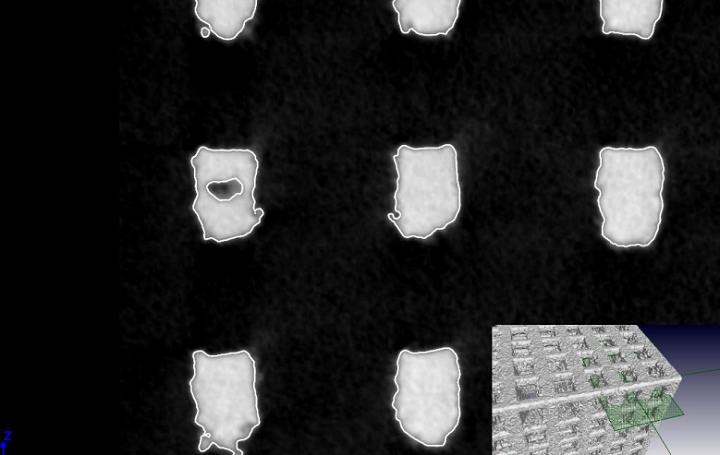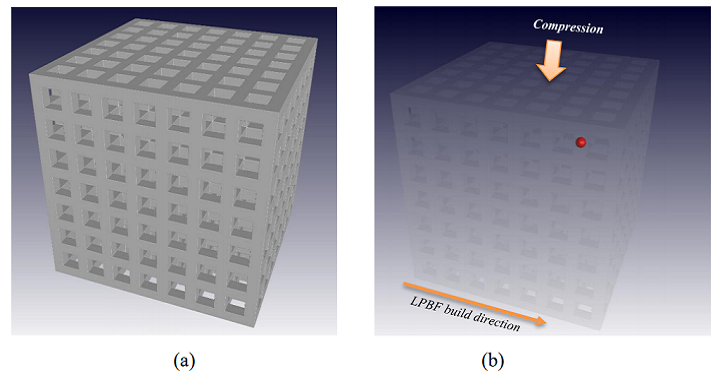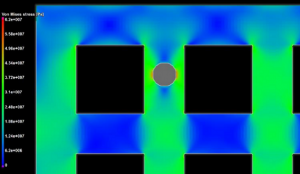Finite Element Modeling Used to Study How Defects Can Effect Porosity in 3D Printed Lattice Structures
A previous study on how porosity can influence the mechanical properties of solid 3D printed titanium alloy Ti6Al4V found that small pores did not have much of an effect, but larger ones with about 5% volume fraction could cause a major loss of these properties. So the potential exists that small pores could be harmless, but it’s not been determined without a doubt yet.
To analyze the deformation and stress distributions in lattice structures, and to interpret failure mechanisms, one can use finite element modeling (FEM), which is a practical way to evaluate designs without spending too much time and money making prototype structures.
A team of researchers from Stellenbosch University and Central University of Technology used a simplified FEM method to investigate how isolated laser powder bed fusion (LPBF) defects could effect maximum local stress concentrations with compressive loading. They explained their research in a paper titled “Numerical and Experimental Study of the Effect of Artificial Porosity in a Lattice Structure Manufactured By Laser Powder Bed Fusion.”
Compressive load simulation (elastic regime) shows higher stresses in vertical struts, and increased stress in the strut containing the pore.
The abstract reads, “While lattices have been investigated widely, the effect of manufacturing flaws on the lattice performance was not yet analyzed in detail. One important type of manufacturing flaw which can be relatively easily analyzed numerically and experimentally is unwanted voids or porosity. In this work, using a simple cubic lattice structure as a test case, pores with varying sizes were induced in a single strut and compressive loading simulated. Ti6Al4V ELI (extra low interstitial) lattices produced by laser powder bed fusion, with and without induced pores, were subjected to mechanical compression tests. MicroCT images validated the presence and size of the induced voids in produced samples. The mechanical compression results show that even relatively large pores in individual load-bearing struts do not affect the ultimate compressive strength of these particular lattice shapes studied and for individual large pores.”
The researchers added a spherical defect into a 3D printed lattice structure’s single strut, and measured the maximum stresses at the adjacent strut and the edge of the defect. For comparison, a square defect rotated by 45° relative to loading direction was also introduced to the structure.
“LPBF Ti6Al4V ELI (extra low interstitial) samples with and without artificial defects were manufactured and analyzed by high resolution microCT to confirm the presence of the intentional defects and quantify the maximum defect size, prior to compression testing,” the researchers wrote.
“The control samples also contained unexpected pores of smaller diameter, and the intentional pores varied in size. This allows for the first quantitative assessment of the influence of pore defect size on the compressive strength of lattice structures. The microCT data is further used for simulations to investigate the differences between stress distributions of an ideal model and the physical sample.”

Compressive load simulation on microCT data of produced lattice containing intentionally designed spherical pore. This image shows a slice image of the pore from top, indicating the irregular shape. In this case the widest pore diameter is 0.45 mm and the pore is not perfectly spherical as designed.
Autodesk Fusion 360 was used to design regular rectangular lattices, and FEM was performed in a new voxel-based static load simulation in Volume Graphics VGStudioMax 3.0. LPBF technology was used to 3D print 12 samples of lattice cubes on an EOS M 280 3D printer: four without artificial pores, four with 0.5 mm spherical pores, and four with cubic pores of about the same diameter. The researchers positioned the artificial defects inside the horizontal struts of the lattice structures, and carried out compression tests in that direction.
“Compressive loading simulations were performed on design files to investigate the maximum local stresses in the struts due to varying sizes of spherical pores. By introducing a spherical defect of varying size in the lattice model, the resulting maximum local stress in the strut with the pore and the adjacent strut can be obtained,” the researchers wrote.
An example of this type of simulation, using a spherical pore with 0.45 mm diameter, is shown in the figure to the left. When the pore size is larger than the strut, which simulates a failed strut that’s not carrying a load, the stress on the adjacent one increases. This means that smaller pores can result in lower stresses.
However, it’s important to note that real defects produced by LPBF 3D printing are typically elongated, or even irregular, and not rounded or spherical like the test defects used in this study. Irregular defects can sometimes include sharp edges that act like stress concentrators, which is why the researchers also introduced a cube-shaped defect.
Compression tests were carried out on all 12 samples, all of which were shown to contain unintentional porosity. But despite pore size, they did not influence the yield force, which shows that even large pores don’t influence the lattice structure’s yield strength for the given surface roughness.
“It was shown in this work, using numerical simulation and physical compression tests, that additively manufactured lattices may be produced for load bearing applications and the size of unintentionally produced pores will have minimal influence on the strength of the structure. From these results it is clear that not only does lattice design play a major role in the local stresses but also the nature of surface roughness of additive manufactured parts,” the researchers concluded. “It can be expected that reduction of stresses with less sharp corners in the lattice design, and less rough surface, will lead to stronger structures, and may be especially valuable for increasing fatigue life.”
Co-authors of the paper are Anton Du Plessis, Ina Yadroitsava, Dean-Paul Kouprianoff, and Igor Yadroitsev.
Discuss this research and other 3D printing topics at 3DPrintBoard.com or share your thoughts in the comments below.
Subscribe to Our Email Newsletter
Stay up-to-date on all the latest news from the 3D printing industry and receive information and offers from third party vendors.
Print Services
Upload your 3D Models and get them printed quickly and efficiently.
You May Also Like
Making 3D Printing Personal: How Faraz Faruqi Is Rethinking Digital Design at MIT CSAIL
What if your 3D printer could think more like an intelligent assistant, able to reason through a design idea, ask questions, and deliver something that works exactly the way the...
Reinventing Reindustrialization: Why NAVWAR Project Manager Spencer Koroly Invented a Made-in-America 3D Printer
It has become virtually impossible to regularly follow additive manufacturing (AM) industry news and not stumble across the term “defense industrial base” (DIB), a concept encompassing all the many diverse...
Heating Up: 3D Systems’ Scott Green Discusses 3D Printing’s Potential in the Data Center Industry
The relentless rise of NVIDIA, the steadily increasing pledges of major private and public investments in national infrastructure projects around the world, and the general cultural obsession with AI have...
Formlabs Teams Up with DMG MORI in Japan
In late June, Nick Graham, Chief Revenue Officer at Formlabs, announced on LinkedIn that the company had partnered with DMG MORI, one of the world’s leading machine tool companies, to...





































